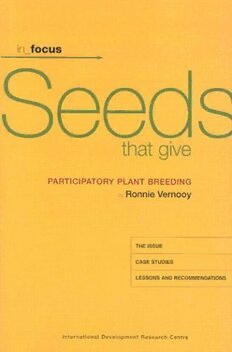
Seeds That Give: Participatory Plant Breeding (In Focus) PDF
63 Pages·2003·0.33 MB·English
Most books are stored in the elastic cloud where traffic is expensive. For this reason, we have a limit on daily download.
Preview Seeds That Give: Participatory Plant Breeding (In Focus)
Description:
Today’s agriculture is like a huge inverted pyramid; globally, it rests on a precariously narrow base. Less than 3% of the 250 000 plant varieties available to agriculture are in use today. The top-down system of agricultural research, where farmers are seen merely as recipients of research rather than as participants in it, has contributed to this dependence on a relatively few plant varieties. This trend and the increasing industrialization of agriculture are key factors in what can only be called "genetic erosion".A new approach to agricultural research and development is needed to conserve diversity, improve crops, and produce quality food for all. This publication examines one such approach: participatory plant breeding. Drawing from a decade of IDRC research support in agricultural biodiversity, this book examines the key issues, from the design of on-farm research to farmers’ and plant breeders’ rights. It argues for the development of new, supportive policies and legislation. It presents a series of project stories that illustrate how farmers and plant breeders are working together in remote regions from the Andes to the Himalayas and beyond. In analyzing the results -- both the successes and the shortcomings -- the author presents a series of specific recommendations for governments and organizations involved in agricultural research and development. Finally, the author takes a speculative look 10 years into the future of participatory plant breeding. This book serves as the focal point for an IDRC thematic web site on participatory plant breeding: www.idrc.ca/seeds. The full text is available online and leads the reader into a virtual web of resources that explores a decade of research on agrobiodiversity and participatory plant breeding.
See more
The list of books you might like
Most books are stored in the elastic cloud where traffic is expensive. For this reason, we have a limit on daily download.
